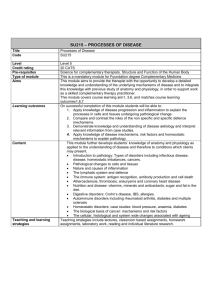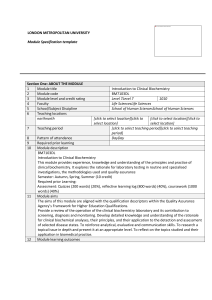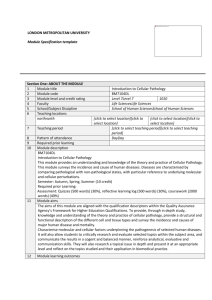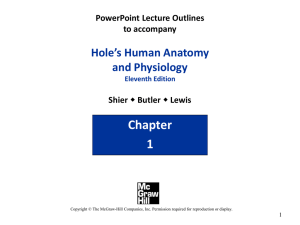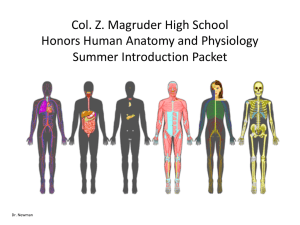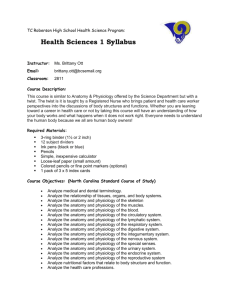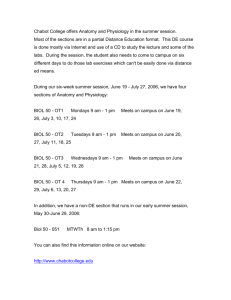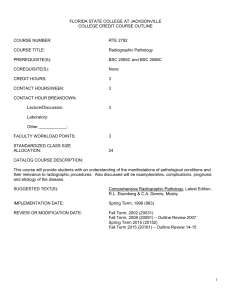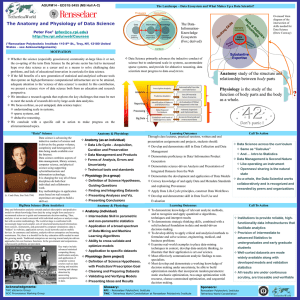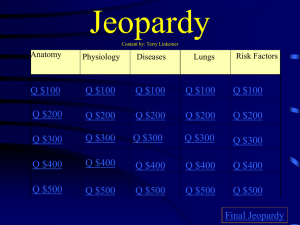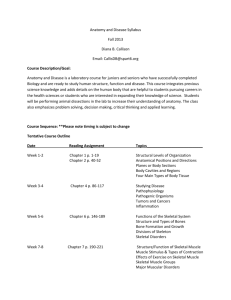BM7110DL
advertisement
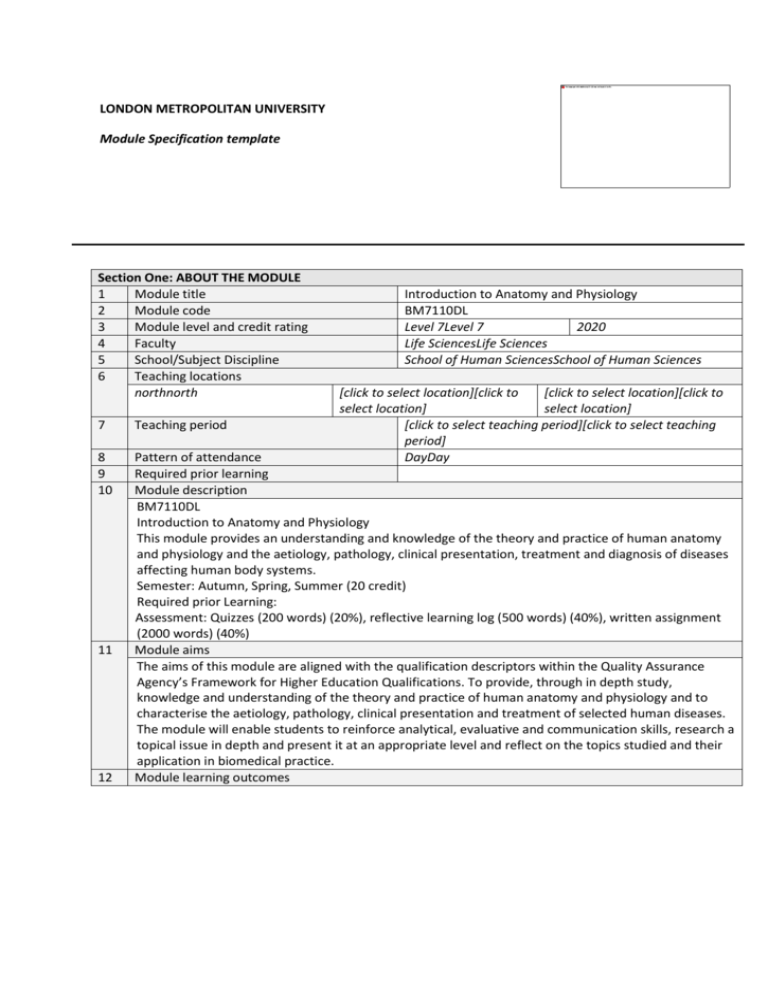
LONDON METROPOLITAN UNIVERSITY Module Specification template Section One: ABOUT THE MODULE 1 Module title 2 Module code 3 Module level and credit rating 4 Faculty 5 School/Subject Discipline 6 Teaching locations northnorth Introduction to Anatomy and Physiology BM7110DL Level 7Level 7 2020 Life SciencesLife Sciences School of Human SciencesSchool of Human Sciences [click to select location][click to [click to select location][click to select location] select location] [click to select teaching period][click to select teaching period] DayDay 7 Teaching period 8 9 10 Pattern of attendance Required prior learning Module description BM7110DL Introduction to Anatomy and Physiology This module provides an understanding and knowledge of the theory and practice of human anatomy and physiology and the aetiology, pathology, clinical presentation, treatment and diagnosis of diseases affecting human body systems. Semester: Autumn, Spring, Summer (20 credit) Required prior Learning: Assessment: Quizzes (200 words) (20%), reflective learning log (500 words) (40%), written assignment (2000 words) (40%) Module aims The aims of this module are aligned with the qualification descriptors within the Quality Assurance Agency’s Framework for Higher Education Qualifications. To provide, through in depth study, knowledge and understanding of the theory and practice of human anatomy and physiology and to characterise the aetiology, pathology, clinical presentation and treatment of selected human diseases. The module will enable students to reinforce analytical, evaluative and communication skills, research a topical issue in depth and present it at an appropriate level and reflect on the topics studied and their application in biomedical practice. Module learning outcomes 11 12 13 14 15 16 17 On successful completion of this module students will be able to: 1. Demonstrate an understanding of the anatomy and physiology of human body systems and the mechanisms of homeostatic control and the aetiology, pathology, clinical presentation and treatment of common diseases affecting human body systems. 2. Think critically in analysing and solving problems on anatomy, physiology, pathology and disease and research, evaluate, and discuss key issues within the subject area and communicate the results in a cogent and balanced manner. 3. Demonstrate through the reflective learning journal that the student has reflected on their own performance as an independent professional learner. Indicative syllabus – for full details see section C in Module Booklet Human anatomy and physiology: an introduction to the anatomical structure and physiological function of human body systems, including the immune, integumentary, nervous, endocrine, musculoskeletal, cardiovascular, respiratory and renal systems. Pathology and disease processes: cellular and tissue pathology, mechanisms of cell injury, cellular adaptation to stress, necrosis and apoptosis; classifications, aetiology and mechanisms of disease processes; system-specific diseases: autoimmune and immunodeficiency disorders, dermatological disorders, neurological disorders, endocrine disorders, metabolic bone diseases, bone fractures, osteomyelitis & bone tumours, cardiovascular diseases, respiratory diseases, nutritional deficiencies, renal disorders. Focus on current health issues (UK): Alcohol, obesity and diabetes. Indicative bibliography and key on-line resources – for full details see section D in Module Booklet Carton J, Daly D, Ramani P. (2007) Clinical Pathology. Oxford University Press. Cohen BJ. (2010) Memmler’s The Human Body in Health and Disease 11th Ed. Lippincott Williams & Wilkins. Damjanov I. (2006) Pathology for the Health Professions 3rd Ed. Elsevier Saunders. Gould B. (2006) Pathophysiology for the Health Professions 3rd Ed. Saunders Kumar P, Clark M. (2005) Clinical Medicine 6th Ed. Saunders. Phillips JD (2007) The Biology of Disease. 2nd Ed. Blackwell. Learning and Teaching strategy for the module including approach to blended learning, students’ study responsibilities and opportunities for reflective learning/pdp Information pertaining to the subject matter will be presented through an integrated programme of lectures and supporting exercises, together with some use of a problem-based learning approach and the guided use of student-centred learning resources. Lectures will be used to provide a conceptual framework. Student centred assignments will enable students to reinforce and expand their knowledge, and develop subject specific skills and competence. Indicative learning and teaching hours for the module. Learning hours comprise face-to-face and virtual contact hours plus self-managed and directed learning and time spent on placements (where relevant). Method Description and percentage of learning hours Scheduled learning and teaching activities Guided independent study 200 (100%) Total Learning hours for the module 200 Assessment strategy The module will be formatively assessed by in-course online quizzes (20%) and two coursework components. A reflective learning log (500 words) (40%) and a written assignment (40%; 2000 words). Criteria for assessment will include an understanding of the subject matter; an ability, both orally and written, to explain, describe and discuss the work; completeness and conciseness of written reports and essays with emphasis upon critical ability and scientific rigour. To pass the module students need to achieve a minimum aggregate mark of 50%. 18 19 Component Learning outcomes Quizzes 1,2 Reflective learning log 3 Written assignment 2,3 Arrangements for formative and summative feedback Written feedback on the coursework will be given at the end of the module Description of assessment items Assessment Method Practical ExamPractical Exam CourseworkCour sework CourseworkCour sework Description of Item % weighting Week Due On-line Quizzes (200 words) 20 Reflective learning log (500 words) 40 12 Written assignment (ECA) (1000 words) 40 14 Section Two: FACULTY USE 20 Nominated External Examiner 21 Nominated Module Leader at time of approval 22 Courses to which this module contributes and whether Core or Option If not pass on aggregate, explain what is required to pass the module Dr David MacDonald Section Three: OFFICIAL USE AND CODES – responsibility for completion is as indicated 23 Original date of approval (QEU) 24 Module approved to run from (QEU) 25 Revision date (specify cohort) (QEU) 26 Module specification version number (QEU) 27 SITS Mark Scheme (Academic Registry) 28 Subject Standards Board Name (Academic Registry)
